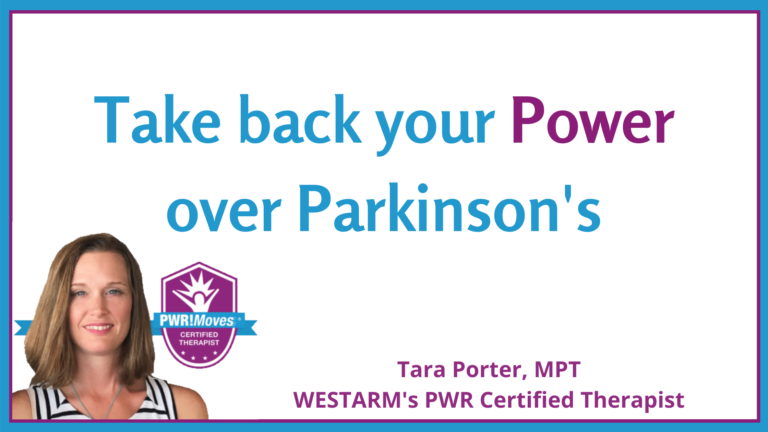
WHY FIND A PHYSICAL THERAPIST FOR PARKINSON’S?
Physical therapists can be helpful at all stages of Parkinson’s Disease (PD). Movement impairments in the initial stages of the disease are not always obvious. By not engaging a physical therapist with a neurological specialization as part of their medical team, people with Parkinson’s often miss the window of opportunity to address these impairments early. Talk to your doctor about getting a baseline physical therapy evaluation and then continue with periodic re-evaluations.
According to the Parkinson’s Outcomes Project, the largest clinical study of Parkinson’s disease through our Centers of Excellence network, increasing physical activity to at least 2.5 hours a week can slow decline in quality of life. The Parkinson’s Foundation has identified specific care approaches associated with better outcomes across patients who seek expert care at our designated care centers. Among others, best practices include early referral to physical therapy and encouragement of exercise as part of treatment.
A physical therapist is uniquely trained to design an exercise routine that targets specific motor impairments. Physical therapists also have an opportunity to provide frequent, direct feedback to help make you aware of how to exercise most effectively and safely.
Parkinson’s Disease
Parkinson’s disease is a progressive nervous system disorder that affects movement. Symptoms start gradually, sometimes starting with a barely noticeable tremor in just one hand. Tremors are common, but the disorder also commonly causes stiffness or slowing of movement.
In the early stages of Parkinson’s disease, your face may show little or no expression. Your arms may not swing when you walk. Your speech may become soft or slurred. Parkinson’s disease symptoms worsen as your condition progresses over time.
Although Parkinson’s disease cannot be cured, medications and therapy can significantly improve your symptoms. Occasionally, your doctor may suggest surgery to regulate certain regions of your brain and improve your symptoms.
Parkinson’s disease signs and symptoms can be different for each patient. Early signs may be mild and go unnoticed. Symptoms often begin on one side of your body and usually remain worse on that side, even after symptoms begin to affect both sides.
Parkinson’s signs and symptoms may include:
- A tremor, or shaking- usually begins in a limb, often in your hand or fingers. You may rub your thumb and forefinger back and forth, known as a pill-rolling tremor. Your hand may tremble when it’s at rest.
- Slowed movement (bradykinesia)- Over time, Parkinson’s disease may slow your movement, making simple tasks difficult and time-consuming. Your steps may become shorter when you walk. It may be difficult to get out of a chair. You may drag your feet as you try to walk.
- Rigid muscles- Muscle stiffness may occur in any part of your body. The stiff muscles can be painful and limit your range of motion.
- Impaired posture and balance- Your posture may become stooped, or you may have balance problems as a result of Parkinson’s disease.
- Loss of automatic movements- You may have a decreased ability to perform unconscious movements, including blinking, smiling, or swinging your arms when you walk.
- Speech changes- You may speak softly, quickly, slur or hesitate before talking. Your speech may be more of a monotone rather than have the usual inflections.
- Writing changes- It may become hard to write, and your writing may appear small.
Risk factors for Parkinson’s disease include:
- Young adults rarely experience Parkinson’s disease. It ordinarily begins in middle or late life, and the risk increases with age. People usually develop the disease around age 60 or older.
- Having a close relative with Parkinson’s disease increases the chances that you’ll develop the disease. However, your risks are still small unless you have many relatives in your family with Parkinson’s disease.
- Men are more likely to develop Parkinson’s disease than are women.
- Exposure to toxins. Ongoing exposure to herbicides and pesticides may slightly increase your risk of Parkinson’s disease.
Diagnosis
No specific test exists to diagnose Parkinson’s disease. Your doctor trained in nervous system conditions (neurologist) will diagnose Parkinson’s disease based on your medical history, a review of your signs and symptoms, and a neurological and physical examination. Sometimes it takes time to diagnose Parkinson’s disease. Doctors may recommend regular follow-up appointments with neurologists trained in movement disorders to evaluate your condition and symptoms over time and diagnose Parkinson’s disease.
A Physical Therapist can provide:
- Education and self-management advice.
- Exercise routines that have been associated with improvements (or slower declines) in mobility, quality of life, and disease severity.
- Answers to questions about the type, intensity, frequency, or duration of exercise that is best for you.
- Ways to maintain safety when exercising.
- Help with:
- Normal physical activity routine
- Walking: slowness, small steps, or freezing (feeling glued to the floor or difficulty getting started)
- Balance or stability
- Posture
- Pain
- Moving around the house (getting up from a chair, moving around in bed)
- Getting around (in/out of a car or bus, elevators, stairs, and uneven ground)
- Addressing fear of falling, have fallen, or are worried about your safety.
- Other health problems that affect mobility, including joint or muscle pain from arthritis, problems with endurance due to a heart or lung condition, a broken bone or surgery
Setting Movement Goals with your Therapist
Every patient works with their physical therapist to set individualized movement goals. Physical therapists can help you optimize your exercise routine based on the latest research, re-learn challenging tasks, or stay safe and independent in the home. Some of the most common movement goals for people with Parkinson’s include:
- Learning about exercises
- Improving walking, balance, or posture
- Addressing fall risk
- Treating pain
Before your first visit, think about your movement goals and write down your problems and questions. This will help you to organize your thoughts. You can do this for future visits, too.
To learn even more about Parkinson’s Disease, check out this video created by The Michael J. Fox Foundation for Parkinson’s Research. The Michael J. Fox Foundation is dedicated to finding a cure for Parkinson’s disease through an aggressively funded research agenda and to ensuring the development of improved therapies for those living with Parkinson’s today. If you’d like to donate to the Michael J. Fox Foundation you can do so below.
Schedule an appointment with Tara Today

Leechburg Facility
Kiski Park Plaza
1001 South Leechburg Hill Road
Leechburg, PA 15656